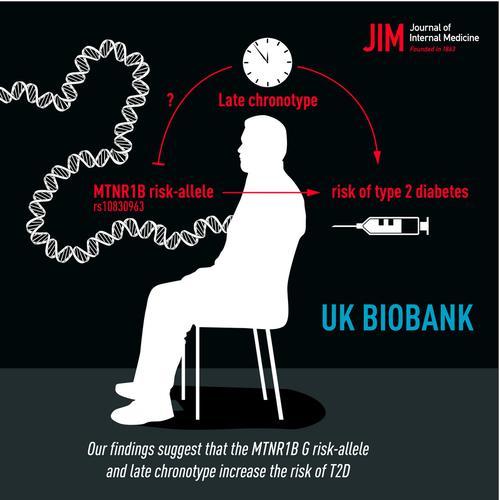当前位置:
X-MOL 学术
›
J. Intern. Med.
›
论文详情
Our official English website, www.x-mol.net, welcomes your
feedback! (Note: you will need to create a separate account there.)
Associations between chronotype, MTNR1B genotype and risk of type 2 diabetes in UK Biobank.
Journal of Internal Medicine ( IF 9.0 ) Pub Date : 2019-10-17 , DOI: 10.1111/joim.12994 X Tan 1 , D-M Ciuculete 1 , H B Schiöth 1, 2 , C Benedict 1
Journal of Internal Medicine ( IF 9.0 ) Pub Date : 2019-10-17 , DOI: 10.1111/joim.12994 X Tan 1 , D-M Ciuculete 1 , H B Schiöth 1, 2 , C Benedict 1
Affiliation

|
OBJECTIVE
To examine the association between the MTNR1B G risk allele, type 2 diabetes (T2D) and chronotype in the UK Biobank.
METHODS
Data from the baseline investigation of the UK Biobank were utilized (n = 337 083 White British; mean age: 56.9 years; 54% women). MTNR1B rs10830963 was directly genotyped [CC (reference group), CG and GG]. Chronotype was divided into four categories: definitely morning (reference group); more morning than evening; more evening than morning; and definitely evening. Logistic regression analyses were performed to estimate odds ratios and 95% confidence intervals (CIs) for T2D, controlling for age, sex and other confounders.
RESULTS
Carriers of the rs10830963 risk allele had a higher risk of T2D [CG vs. CC: OR (95% CI) 1.10 (1.07, 1.15); GG vs. CC: 1.21 (1.14, 1.29)]. Compared with definitely morning chronotype, participants with definitely evening chronotype exhibited the highest risk of T2D [1.25 (1.17, 1.33)]. Despite a nonsignificant interaction between chronotype and the risk allele [0.98 (0.94, 1.01), P = 0.176 for interaction term], we found that definitely evening chronotype (vs. definitely morning) was linked with a higher risk of T2D amongst CC and CG but not GG carriers. Additionally, we saw that the GG genotype (vs. CC) was associated with a higher risk of T2D across all chronotype categories, except for definitely evening.
CONCLUSION
Our findings suggest that the MTNR1B G risk allele and late chronotype increase the risk of T2D. The association between late chronotype and higher risk of T2D appears to vary across MTNR1B rs10830963 genotypes.
中文翻译:

英国生物库中的表型,MTNR1B基因型与2型糖尿病风险之间的关联。
目的探讨英国生物库中MTNR1B G风险等位基因,2型糖尿病(T2D)与表型之间的关联。方法利用英国生物库基线调查的数据(n = 337 083美国白人;平均年龄:56.9岁; 54%为女性)。直接对MTNR1B rs10830963进行了基因分型[CC(参考组),CG和GG]。计时型分为四类:肯定是早晨(参考组);早上比晚上多 晚上比早晨多;绝对是晚上。进行了逻辑回归分析以估计T2D的优势比和95%置信区间(CIs),并控制了年龄,性别和其他混杂因素。结果rs10830963风险等位基因携带者的T2D风险较高[CG vs. CC:OR(95%CI)1.10(1.07,1.15);GG vs. CC:1.21(1.14,1.29)]。与肯定的早晨表型相比,肯定具有晚间型的参与者表现出最高的T2D风险[1.25(1.17,1.33)]。尽管表型与风险等位基因之间没有显着的相互作用[0.98(0.94,1.01),交互作用项的P = 0.176],但我们发现,CC和CG中明确的傍晚表型(相对于肯定的早晨)与较高的T2D风险相关。但没有GG航母。此外,我们发现,除了明确的傍晚,在所有表型类别中,GG基因型(相对于CC)与较高的T2D风险相关。结论我们的研究结果提示MTNR1B G风险等位基因和晚期表型增加了T2D的风险。在不同的MTNR1B rs10830963基因型之间,晚期表型与较高的T2D风险之间的相关性似乎有所不同。尽管表型与风险等位基因之间没有显着的相互作用[0.98(0.94,1.01),交互作用项的P = 0.176],但我们发现,CC和CG中明确的傍晚表型(相对于肯定的早晨)与较高的T2D风险相关。但没有GG航母。此外,我们发现,除了明确的傍晚,在所有表型类别中,GG基因型(相对于CC)与较高的T2D风险相关。结论我们的研究结果提示MTNR1B G风险等位基因和晚期表型增加了T2D的风险。在不同的MTNR1B rs10830963基因型之间,晚期表型与较高的T2D风险之间的相关性似乎有所不同。尽管表型与风险等位基因之间没有显着的相互作用[0.98(0.94,1.01),交互作用项的P = 0.176],但我们发现,CC和CG中明确的傍晚表型(相对于肯定的早晨)与较高的T2D风险相关。但没有GG航母。此外,我们发现,除了明确的傍晚,GG基因型(相对于CC)与所有表型类别中的T2D风险较高相关。结论我们的研究结果提示MTNR1B G风险等位基因和晚期表型增加了T2D的风险。在不同的MTNR1B rs10830963基因型之间,晚期表型与较高的T2D风险之间的相关性似乎有所不同。肯定是早晨)与CC和CG中的T2D风险较高有关,但与GG携带者无关。此外,我们发现,除了明确的傍晚,GG基因型(相对于CC)与所有表型类别中的T2D风险较高相关。结论我们的研究结果提示MTNR1B G风险等位基因和晚期表型增加了T2D的风险。在不同的MTNR1B rs10830963基因型之间,晚期表型与较高的T2D风险之间的相关性似乎有所不同。肯定是早晨)与CC和CG中的T2D风险较高有关,但与GG携带者无关。此外,我们发现,除了明确的傍晚,在所有表型类别中,GG基因型(相对于CC)与较高的T2D风险相关。结论我们的研究结果提示MTNR1B G风险等位基因和晚期表型增加了T2D的风险。在不同的MTNR1B rs10830963基因型之间,晚期表型与较高的T2D风险之间的相关性似乎有所不同。
更新日期:2019-11-06
中文翻译:

英国生物库中的表型,MTNR1B基因型与2型糖尿病风险之间的关联。
目的探讨英国生物库中MTNR1B G风险等位基因,2型糖尿病(T2D)与表型之间的关联。方法利用英国生物库基线调查的数据(n = 337 083美国白人;平均年龄:56.9岁; 54%为女性)。直接对MTNR1B rs10830963进行了基因分型[CC(参考组),CG和GG]。计时型分为四类:肯定是早晨(参考组);早上比晚上多 晚上比早晨多;绝对是晚上。进行了逻辑回归分析以估计T2D的优势比和95%置信区间(CIs),并控制了年龄,性别和其他混杂因素。结果rs10830963风险等位基因携带者的T2D风险较高[CG vs. CC:OR(95%CI)1.10(1.07,1.15);GG vs. CC:1.21(1.14,1.29)]。与肯定的早晨表型相比,肯定具有晚间型的参与者表现出最高的T2D风险[1.25(1.17,1.33)]。尽管表型与风险等位基因之间没有显着的相互作用[0.98(0.94,1.01),交互作用项的P = 0.176],但我们发现,CC和CG中明确的傍晚表型(相对于肯定的早晨)与较高的T2D风险相关。但没有GG航母。此外,我们发现,除了明确的傍晚,在所有表型类别中,GG基因型(相对于CC)与较高的T2D风险相关。结论我们的研究结果提示MTNR1B G风险等位基因和晚期表型增加了T2D的风险。在不同的MTNR1B rs10830963基因型之间,晚期表型与较高的T2D风险之间的相关性似乎有所不同。尽管表型与风险等位基因之间没有显着的相互作用[0.98(0.94,1.01),交互作用项的P = 0.176],但我们发现,CC和CG中明确的傍晚表型(相对于肯定的早晨)与较高的T2D风险相关。但没有GG航母。此外,我们发现,除了明确的傍晚,在所有表型类别中,GG基因型(相对于CC)与较高的T2D风险相关。结论我们的研究结果提示MTNR1B G风险等位基因和晚期表型增加了T2D的风险。在不同的MTNR1B rs10830963基因型之间,晚期表型与较高的T2D风险之间的相关性似乎有所不同。尽管表型与风险等位基因之间没有显着的相互作用[0.98(0.94,1.01),交互作用项的P = 0.176],但我们发现,CC和CG中明确的傍晚表型(相对于肯定的早晨)与较高的T2D风险相关。但没有GG航母。此外,我们发现,除了明确的傍晚,GG基因型(相对于CC)与所有表型类别中的T2D风险较高相关。结论我们的研究结果提示MTNR1B G风险等位基因和晚期表型增加了T2D的风险。在不同的MTNR1B rs10830963基因型之间,晚期表型与较高的T2D风险之间的相关性似乎有所不同。肯定是早晨)与CC和CG中的T2D风险较高有关,但与GG携带者无关。此外,我们发现,除了明确的傍晚,GG基因型(相对于CC)与所有表型类别中的T2D风险较高相关。结论我们的研究结果提示MTNR1B G风险等位基因和晚期表型增加了T2D的风险。在不同的MTNR1B rs10830963基因型之间,晚期表型与较高的T2D风险之间的相关性似乎有所不同。肯定是早晨)与CC和CG中的T2D风险较高有关,但与GG携带者无关。此外,我们发现,除了明确的傍晚,在所有表型类别中,GG基因型(相对于CC)与较高的T2D风险相关。结论我们的研究结果提示MTNR1B G风险等位基因和晚期表型增加了T2D的风险。在不同的MTNR1B rs10830963基因型之间,晚期表型与较高的T2D风险之间的相关性似乎有所不同。











































 京公网安备 11010802027423号
京公网安备 11010802027423号